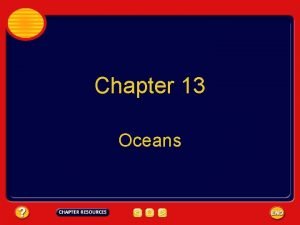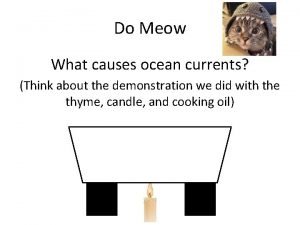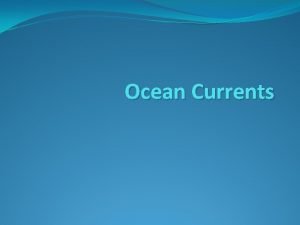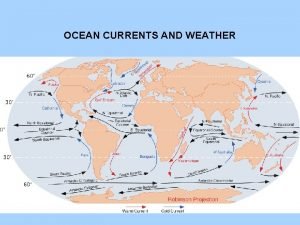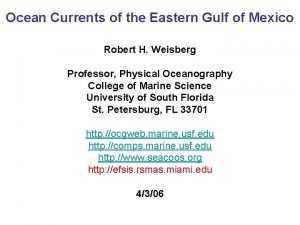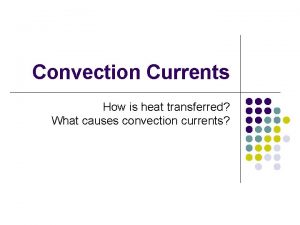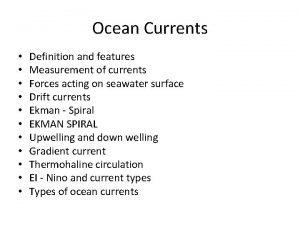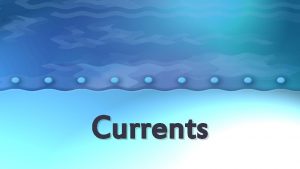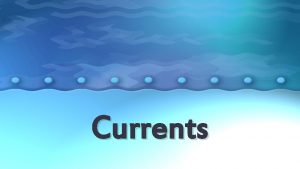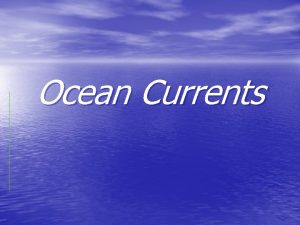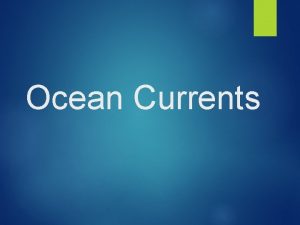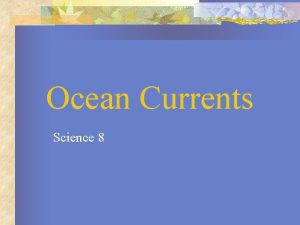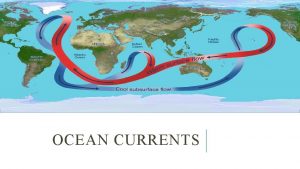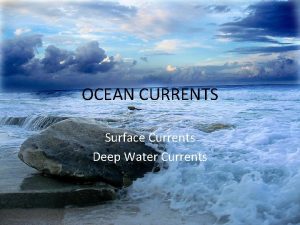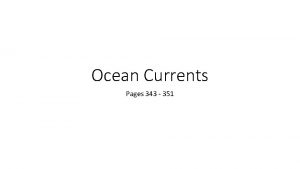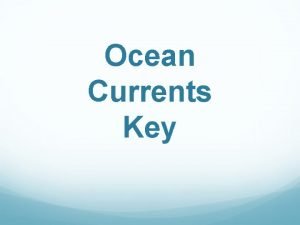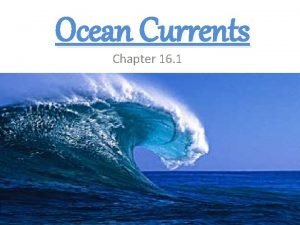Ocean Currents 65 Ocean currents are a mass














- Slides: 14

Ocean Currents (65) • Ocean currents are a mass movement, or flow, of ocean water. • An ocean current is like a river within the ocean.

• Surface currents move water horizontally— parallel to Earth’s surface. • These currents are powered by wind. • Surface currents move only the upper few hundred meters of seawater. • The Coriolis effect is the shifting of winds and surface currents from their expected paths that is caused by Earth’s rotation. • Because Earth rotates toward the east, winds appear to curve to the right in the northern hemisphere and to the left in the southern hemisphere.

How Surface Current Form • Surface winds can cause water to pile up in certain parts of the ocean. • When gravity pulls water off the pile, the Coriolis effect turns the water. • The Coriolis effect causes currents north of the equator to turn to the right. Currents south of the equator are turned left. • http: //www. youtube. com/w atch? v=Hu_Ga 0 JYFNg

http: //www. youtube. com/watch? v= YCorky. Be 66 o • Drift bottles containing messages and numbered cards are released from a variety of costal locations. • The bottles are carried by surface currents and might end up on a beach. • The person who finds a bottle writes down the date and the location where the bottle was found. • Then the card is sent back to the institution that launched the bottle.

Warm and Cold Surface Currents • Currents on the west coasts of continents begin near the poles where the water is colder. • East-coast currents originate near the equator where the water is warmer. • As warm water flows away from the equator, heat is released to the atmosphere. • The atmosphere is warmed.

Upwelling • Upwelling is a vertical circulation in the ocean that brings deep, cold water to the ocean surface. • Wind blowing parallel to the coast carries water away from the land because of the Coriolis effect.

. • Cold, deep ocean water rises to the surface and replaces water that has moved away from shore. • This water contains high concentrations of nutrients from organisms that died. • Nutrients promote primary production and plankton growth, which attracts fish. • Areas of upwelling create important fishing grounds

Density Currents • A density current forms when a mass of seawater becomes more dense than the surrounding water. • Gravity causes more dense seawater to sink beneath less dense seawater. • The density of seawater increases if salinity increases. • It also increases when temperature decreases. • http: //www. youtube. com/watch? v=Fu. OX 23 y Xh. Z 8

Deep Waters • Important density current begins in Antarctica. • ice forms, seawater freezes, but the salt is left behind in the unfrozen water. • Extra salt increases salinity and increased salinity make ocean water denser. • This dense water sinks and slowly spreads along the ocean bottom toward the equator, forming a density current. • In the North Atlantic Ocean, cold, dense water forms North Atlantic Deep Water. • The dense waters circulate more quickly in the Atlantic Ocean than in the Pacific Ocean.

Intermediate Waters • A density current also occurs in the Mediterranean Sea. • The warm temperatures and dry air in the region cause large amounts of water to evaporate from the surface of the sea. • This evaporation increases the salinity and density of the water.

• The Mediterranean is less dense than the very cold, salty water flowing from the North Atlantic Ocean. • The Mediterranean water forms a middle layer of water—the Mediterranean Intermediate Water

_____ move water horizontally and parallel to Earth’s surface. • A. Coriolis effects • B. Density currents • C. Surface currents • D. Upwellings

What is an upwelling? An upwelling is a vertical circulation in the ocean that brings deep, cold water to the ocean surface.

• How does a density current form? A density current forms when a mass of seawater becomes denser than the surrounding water. The density of seawater increases if salinity increases or temperature decreases.
 Mikael ferm
Mikael ferm Compared with surface currents deep currents are
Compared with surface currents deep currents are Cold peruvian current
Cold peruvian current Ocean currents waves and tides
Ocean currents waves and tides Rubber ducks ocean currents activity
Rubber ducks ocean currents activity Brainpop ocean currents
Brainpop ocean currents What are ocean currents
What are ocean currents Cenozoic mammals
Cenozoic mammals Ocean currents vocabulary
Ocean currents vocabulary Gyre
Gyre Ocean currents gulf of mexico
Ocean currents gulf of mexico Ocean currents
Ocean currents Factors affecting their climate
Factors affecting their climate What causes convection currents in the mantle
What causes convection currents in the mantle What are ocean currents
What are ocean currents


